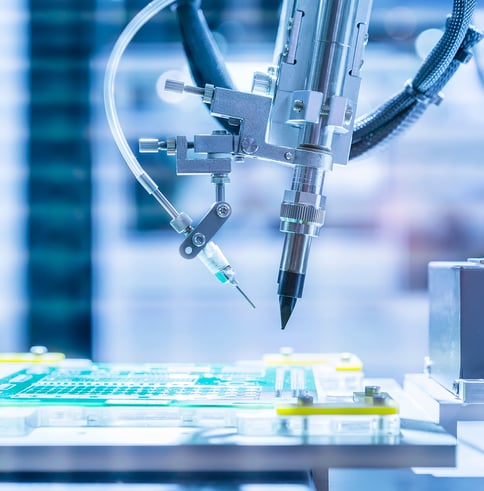The COVID-19 outbreak was a game changer and a wake-up call for many industries, including manufacturing.
With the shortage of workers and the surging consumer demand for products, the COVID-19 crisis forced manufacturing companies to adapt quickly to the new circumstances by increasing their efforts to automate processes.
Hence, the coronavirus outbreak is not only a health issue but also an economic one. It will have long-lasting effects on the global economy as well as the manufacturing industry.
In this article, we will look at the benefits of automation in the manufacturing industry during the pandemic and how it will affect the future of the manufacturing workforce.
Covid-19: A Paradigm Shift for Manufacturing Companies
The manufacturing industry is highly dependent on human workers, which has made it vulnerable to disruption from the coronavirus. The glaring dilemma for manufacturers was this: more demand for products; fewer workers because of social distancing. This situation forced companies to rethink their strategy and reallocate resources to address the crisis to stay open and run smoothly under the new normal and fulfill the surging demand. This created a demand for faster production cycles. And this means that companies must leverage the power of automation to produce the same amount of goods with fewer people.
Automation in Manufacturing During the Pandemic
The manufacturing industry has always had a strong focus on innovation and improvement. It has been known for its ability to develop and implement innovative solutions to address any challenges.
Amid the pandemic, it forced manufacturing companies to adopt automation technologies to keep up with the increased demand for products.
Here’s why they are doing so.
1. Automation helps reduce the risk of infection among employees.
As mentioned earlier, there is a shortage of workers, and thus, manufacturers must work harder than ever before to keep up with the demand for products. However, working in factories can be dangerous because of the high concentration of human workers and the lack of proper protective equipment. Automating some of these processes makes them safer for both workers - and customers.
 2. The process of automation reduces the number of errors that could occur when manual labor is used.
2. The process of automation reduces the number of errors that could occur when manual labor is used.
Because of the shortage of workers, manufacturers must do more with less. This means that they have to rely heavily on technology to help them complete routine tasks of their operations efficiently. For example, if you were to assemble a product manually, you would have to pay attention to every single step of the assembly process. When you add all those steps together, it becomes very easy to make mistakes. If you automate the process, you eliminate most of the potential error sources.
3. Automation increases productivity.
When you combine the two previous points, you get a better understanding of why automation is being used more in manufacturing during the pandemic. It helps manufacturers save time and money while improving quality. By reducing the number of steps involved in repetitive tasks, automation allows factories to operate at higher speeds.
- Automation enables companies to scale up production.
If you want your company to survive through the current crisis, then you need to increase your capacity to handle the growing demand for products. One way to achieve this is through automation.
- Automation improves the overall efficiency of the factory.
There are many reasons automation is used in manufacturing. But what really matters is its ability to improve the overall efficiency of the entire factory. By using automation, manufacturers can cut down on costs, which allows them to invest in other areas of the business.
How will this affect change the manufacturing processes in the future?
The adoption of automation may probably be one of the economic legacies of the pandemic.
- Ben Casselman
 Automation has been happening for decades now, but the last few years during the coronavirus crisis, the pace at which this change is taking place has skyrocketed.
Automation has been happening for decades now, but the last few years during the coronavirus crisis, the pace at which this change is taking place has skyrocketed.
Novel Coronavirus or COVID-19 has brought about a sharp rise in the employment of robots and artificial intelligence in various industries and sectors across the world.
Technology investments are growing. The robotic process automation (RPA) is projected to grow from 43 billion in 2018 to 70.48 million in 2023 at a CAGR of 10.5% rate.
“Once a job is automated, it’s pretty hard to turn back.”
- Casey Warman, an economist at Dalhousie University in Nova Scotia
So, what is the impact of automation for the human workers in our factories?
COVID-19: The Future of the Manufacturing Workforce
The pandemic has brought about a paradigm shift in the way manufacturing companies are approaching automation. It has not only forced us to rethink our approach to manufacturing, but it has also made us reevaluate the role of humans in the workplace.
As we move forward into the post-coronavirus era, technological adoption will continue to play a key role in shaping how factories operate with more companies, adopting digital transformation to automate their entire value chain. And as the manufacturing industry becomes increasingly reliant on automation technology, the human workers need to evolve too.
We will have to learn how to collaborate with machines and how to train our workforce to become more efficient and productive. This will lead to a new wave of job creation and economic growth.
To learn how Radwell International's products and services can impact your operation

